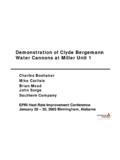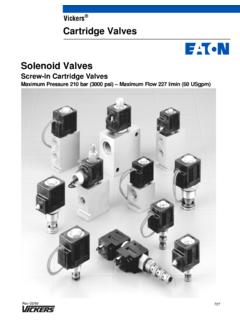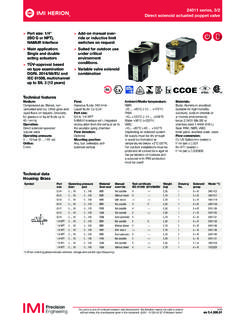Transcription of Soot Blower Lance Tube Corrosion - …
1 SOOT Blower Lance TUBE Corrosion IN RECOVERY BOILERS. M. Ishaq Jameel Honghi Tran Clyde Bergemann, Inc. Pulp & Paper Centre 4015 Presidential Parkway University of Toronto Atlanta, GA, USA Toronto, ON, CANADA. Augusto C. Lovo Nelson Oliveira Aracruz Cellulose Clyde Bergemann do Brasil Aracruz, BRAZIL Mogi Guacu, SP, BRAZIL. ABSTRACT. An investigation was conducted to determine the cause of the internal Corrosion of a number of soot blowers lances installed in two recovery boilers. It was found that the Corrosion was the result of flue gases entering the inside of the Lance tubes and forming an acidic condensate that in turn rapidly attacked the material.
2 Acidic condensate is formed from the condensation of (acidic) flue gases that contained high concentrations HCl and SO2 . The problem was rectified by making improvements to the low pressure air system that ensures the continuous purging of the soot Blower lances to keep the flue gases out. The experience highlights the importance of a properly functioning purge air system for soot blowers. KEYWORDS. Recovery Boiler, Soot Blower , Lance tubes , Corrosion , Dew Point, Mill Experience INTRODUCTION. The accumulation of fireside deposits in a recovery boiler drastically reduces its heat transfer efficiency.
3 This results in high flue gas temperatures which accelerate fouling, leading to the plugging of the downstream passages [1]. In order to maintain uninterrupted operation of the boiler, soot blowers are used to remove deposits and prevent them from excessive buildup. A recovery boiler is typically equipped with over fifty soot blowers in its convective section; these consume 5 to 12% of the total steam produced by the boiler. If soot blowers at critical locations in the boiler are out of service for an extended period of time, massive deposits may build up and lead to an unscheduled shutdown of the boiler.
4 Most soot blowers used in recovery boilers are of the retracting type, consisting of a beam that supports a traveling carriage for inserting and retracting a Lance tube into the boiler. The Lance tube is fitted with a pair of nozzles at its end, which are used to produce high speed steam jets to remove the deposits. High pressure steam is delivered to the Lance via a steam admission valve known as a poppet valve. A feed tube, attached to the poppet valve, passes through an opening in the traveling carriage and ends inside the Lance . Figure 1 shows a schematic of a typical soot Blower hanging off a boiler wall.
5 The Blower is at rest with the Lance tube retracted from the boiler and the nozzle end sitting in a pipe known as the wall sleeve. One end of the soot Blower is attached to boiler steel while the other is attached to the wall sleeve via an intermediary device known as the wall box. This device can be as simple as a steel plate with a hole in the middle to allow for the Lance tube to pass through. In a long, retracting soot Blower , the feed tube that delivers steam from the poppet valve to the Lance is made of stainless steel (typically SS304). The Lance tube is made of a Cr-Mo alloy steel such as T11 that has sufficient strength to support the Lance tube at elevated temperatures while it is in the boiler.
6 The nozzle section at the end of the Lance is made of stainless steel (typically SS310) since it subjected to the hot flue gas longer than any other component of the soot Blower . Over the years, Lance tube Corrosion was found to occur mostly in the part closest to the boiler. The problem was minimized by adding a section of stainless steel (typically SS304) to move the joint further away from the SS310 Lance tip as shown in Figure 2. This is the standard configuration for most soot blowers used in recovery boilers today. Steel beam Boiler wall (wall tube & insulation).
7 Soot Blower beam Lance Wall box Figure 1. Schematic of a retractable soot Blower mounted on a boiler wall Alloy (T11) SS304 SS310. Figure 2 . Typical configuration of recovery service Lance Air flow Steam flow Figure 3. Typical soot Blower steam and air purge system. Since Corrosion of the internal soot Blower components including the Lance tubes has been experienced in the past soot blowers have been equipped for some time with what is known as a purge air systems. A typical configuration is shown in Figure 3. Purge air is introduced to each soot Blower in the vicinity of the boiler wall from an air header.
8 A portion of the air is sent to the wall box and balance to the Lance via the same pipe that carries the steam purge that is used to purge the wall sleeve during the steam cleaning operation of the Blower . During that time a check valve at the connection of the air pipe to the steam purge line isolates the low pressure purge air from the high pressure steam. When the soot Blower is idle, a spring in the check valve opens the valve allowing the purge air to travel to the poppet valve, through the Lance and out of the steam nozzles. Only when air of sufficient pressure and quantity is available at the Lance nozzles is the Lance and feed tube and the soot Blower as a whole are effectively isolated from the aggressive boiler gases.
9 An orifice is used to control the amount of air going to each the wall box and the poppet valve. Without this, the air would select the path of least resistance, which in this case is the wall box. This leaves little to no air flowing towards the Lance . The proper orifice size was determined in tests using air pressures that are typically available in a modern recovery boiler. In most cases the source of air that is the secondary supply to the boiler. Corrosion CASE STUDY. Severe thinning of soot Blower Lance tubes was recently experienced at a kraft mill in Brazil.
10 A number of Lance tubes were reported with high Corrosion rates in a short period of time. The mill has three recovery boilers, A, B and C. Boiler A. underwent a major retrofit in 2001 which included the installation of 98 new soot blowers to compensate for a substantially increased firing capacity. Boiler B was also upgraded at the same time with an addition of 18 new soot blowers to its 82. existing soot blowers. Boiler C is the newest boiler started up in May 1997. Boilers A and B have burned CNCG since June 2002, while Boiler C has not. Corrosion of Lance tubes were found in Boilers A and B around third quarter of 2002.









